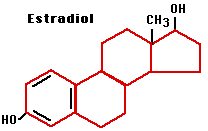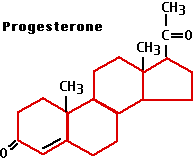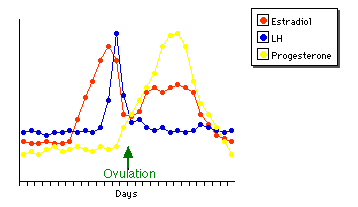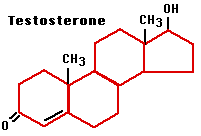 The ovaries of sexually-mature females secrete:
The ovaries of sexually-mature females secrete:
 Progesterone is also a steroid. It has many effects in the body, some having nothing to do with sex and reproduction. Here we shall focus on the role of progesterone in the menstrual cycle and pregnancy [Link to a special page on progesterone].
Progesterone is also a steroid. It has many effects in the body, some having nothing to do with sex and reproduction. Here we shall focus on the role of progesterone in the menstrual cycle and pregnancy [Link to a special page on progesterone].
| Link to a discussion of steroid response elements with a stereo view of a steroid receptor bound to the DNA helix of its response element. |
The synthesis and secretion of estrogens is stimulated by follicle-stimulating hormone (FSH), which is, in turn, controlled by the hypothalamic gonadotropin releasing hormone (GnRH).
| Hypothalamus | -> | GnRH | -> | Pituitary | -> | FSH | -> | Follicle | -> | Estrogens |
High levels of estrogens suppress the release of GnRH providing a negative-feedback control of hormone levels.
Similarly, progesterone production is stimulated by luteinizing hormone (LH), which is also stimulated by GnRH.
| Hypothalamus | -> | GnRH | -> | Pituitary | -> | LH | -> | Corpus luteum | -> | Progesterone |
Elevated levels of progesterone also control themselves by a negative feedback loop with progesterone inhibiting the further release of GnRH.

About every 28 days, some blood and other products of the disintegration of the inner lining of the uterus (the endometrium) are discharged from the uterus, a process called menstruation. During this time a new follicle begins to develop in one of the ovaries. After menstruation ceases, the follicle continues to develop, secreting an increasing amount of estrogen as it does so.
Fertilization of the egg takes place within the fallopian tube. As the fertilized egg passes down the tube, it undergoes its first mitotic divisions. By the end of the week, the developing embryo has become a hollow ball of cells called a blastocyst. At this time, the blastocyst reaches the uterus and embeds itself in the endometrium, a process called implantation. With implantation, pregnancy is established.
The blastocyst has two parts:HCG is a protein. It is a dimer of
HCG behaves much like FSH and LH with one crucial exception: it is NOT inhibited by a rising level of progesterone. Thus HCG prevents the deterioration of the corpus luteum at the end of the fourth week and enables pregnancy to continue beyond the end of the normal menstrual cycle.
Because only the implanted trophoblast makes HCG, its early appearance in the urine of pregnant women provides the basis for the most widely used test for pregnancy (which can provide a positive signal even before menstruation would have otherwise begun).
As pregnancy continues, the placenta becomes a major source of progesterone. In fact, progesterone is essential to maintain pregnancy. Declining levels of progesterone signal that birth is imminent.
| This rise is triggered by the fetus itself: |
Three or four days after the baby is born, the breasts begin to secrete milk.
Relaxin is found in pregnant humans but at higher levels early in pregnancy than close to the time of birth. So whether it has an important role to play in human births remains to be seen.
These proteins are synthesized within the follicle. Activins and inhibins bind to follistatin. Activins increase the action of FSH; inhibins, as their name suggests, inhibit it. How important they are in humans remains to be seen. However the important role that activin and follistatin play in the embryonic development of vertebrates justifies mentioning them here.
The feedback inhibition of GnRH secretion by estrogens and progesterone provides the basis for the most widely-used form of contraception. Dozens of different formulations of synthetic estrogens, progestins (progesterone relatives) or both are available. Their inhibition of GnRH prevents the mid-cycle surge of LH and ovulation. Hence there is no egg to be fertilized.
Usually the preparation is taken for about three weeks and then stopped long enough for normal menstruation to occur.
The main side-effects of the pill stem from an increased tendency for blood clots to form (estrogen enhances clotting of the blood).
These properties of RU-486 have caused it to be used to induce abortion of an unwanted fetus. In practice, the physician assists the process by giving prostaglandins 36-48 hours after giving the dose of RU-486. Use of RU-486 is generally limited to the first seven weeks of pregnancy.
RU-486 has been used for many years in some countries. However, the controversies surrounding abortion in the United States have kept it from being authorized for use here.
The menstrual cycle continues for many years. But eventually, usually between 42 and 52 years of age, the follicles become less responsive to FSH and LH. They begin to secrete less estrogen. Ovulation and menstruation become irregular and finally cease. This cessation is called menopause.
With levels of estrogen now running one-tenth or less of what they had been, the hypothalamus is released from their inhibitory influence. As a result it now stimulates the pituitary to increased activity. The concentrations of FSH and LH in the blood rise to ten or more times their former values. These elevated levels may cause a variety of unpleasant physical and emotional symptoms.
Most of these benefits derive from estrogen. The progestin is taken to reduce the risk of cancer of the endometrium.
There is some evidence that the estrogen component increases the risk of breast cancer as well as of endometrial cancer. For this reason, great effort is being made to develop selective estrogen response modulators (SERMs) or "designer estrogens" which will provide the protective effects without the harmful effects. Stay tuned.
Some substances that find their way into the environment, such as
However, there is as yet little evidence to support these worries.

The principal androgen (male sex hormone) is testosterone. This steroid is manufactured by the interstitial (Leydig) cells of the testes. Secretion of testosterone increases sharply at puberty and is responsible for the development of the so-called secondary sexual characteristics (e.g., beard) of men.
Testosterone is also essential for the production of sperm.
| Link to diagram showing location and structure of the testes. |
Production of testosterone is controlled by the release of luteinizing hormone (LH) from the anterior lobe of the pituitary gland, which is in turn controlled by the release of GnRH from the hypothalamus.
| Hypothalamus | -> | GnRH | -> | Pituitary | -> | LH | -> | Testes | -> | Testosterone |
In 1994, a man was described who was homozygous for a mutation in the gene encoding the estrogen receptor. A single nonsense mutation had converted a codon (CGA) for arginine early in the protein into a STOP codon (TGA). Thus no complete estrogen receptor could be synthesized.
This man was extra tall, had osteoporosis and "knock-knees", but was otherwise well. His genetic defect confirms the important role that estrogen has in both sexes for normal bone development.
It is not known whether this man (or any of the few other men who have been found with the same disorder) is fertile or not. However, an article in the 4 December 1997 issue of Nature reports that male mice whose estrogen receptor gene has been "knocked out" are sterile.
A number of synthetic androgens are used for therapeutic purposes. Unfortunately, these drugs also promote an increase in body weight and muscle strength. This has made them increasingly popular with athletes: weight lifters, cyclists, professional football players, etc.
Often these athletes take doses 100 time greater than those used in standard therapy. Such illicit use carries dangers (besides being banned from an event because of a positive drug test): acne, a decrease in libido, testicle size, and sperm counts to name a few.
| Welcome&Next Search |